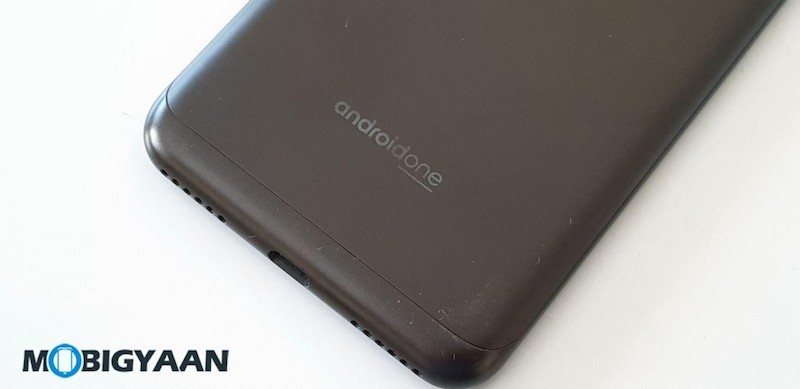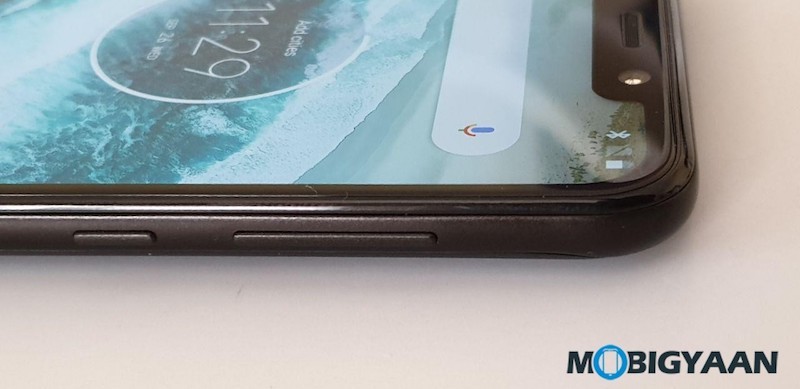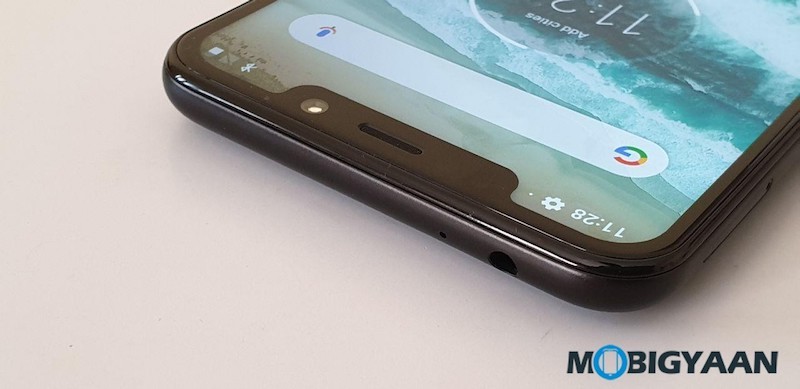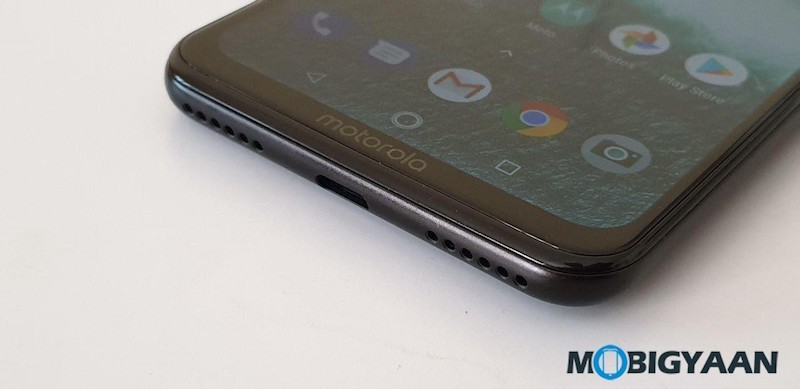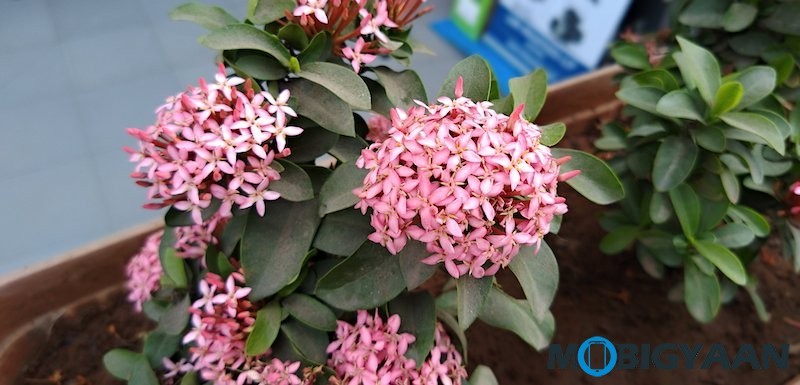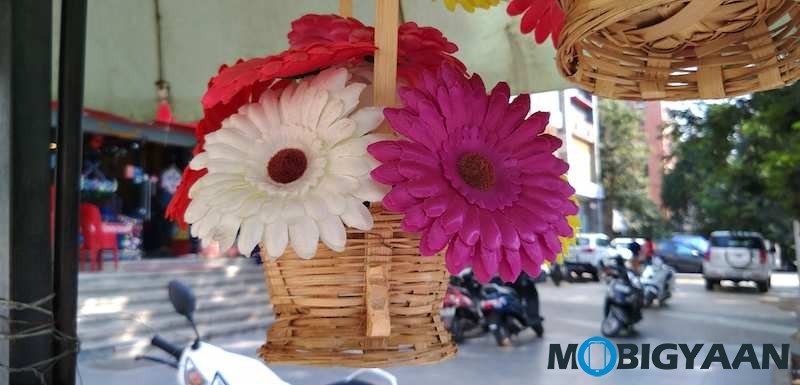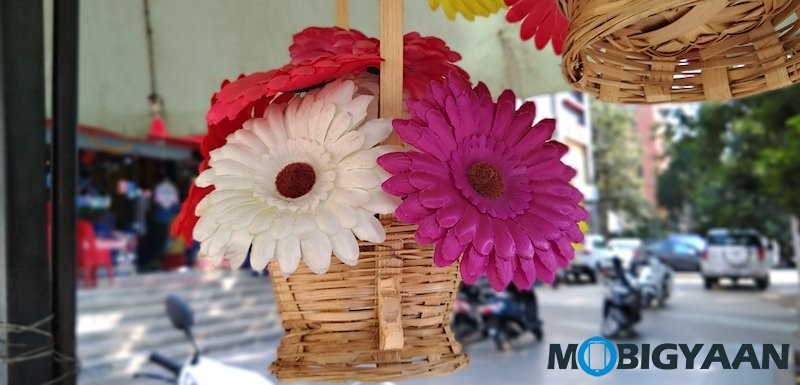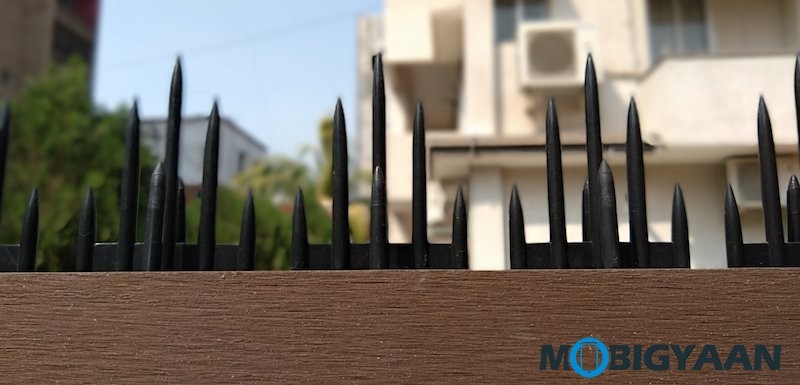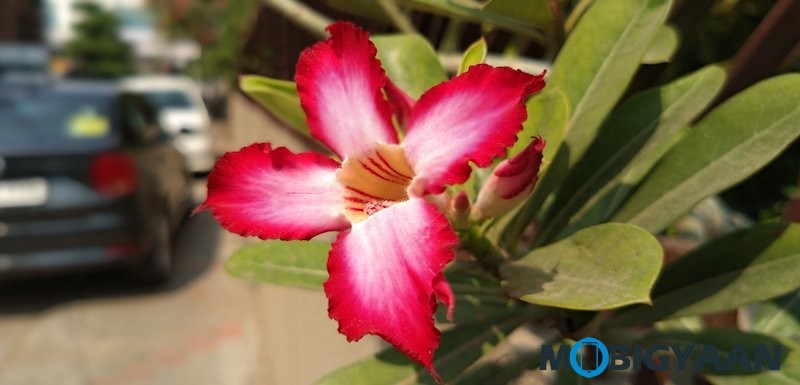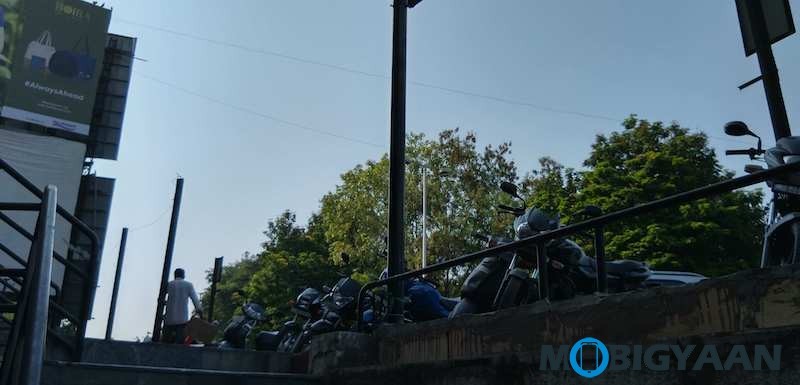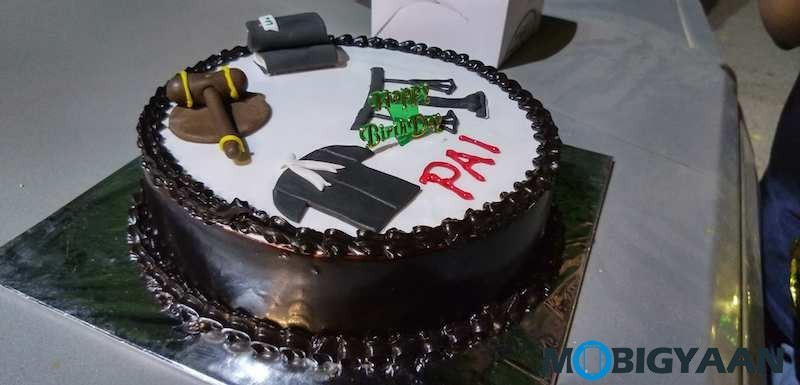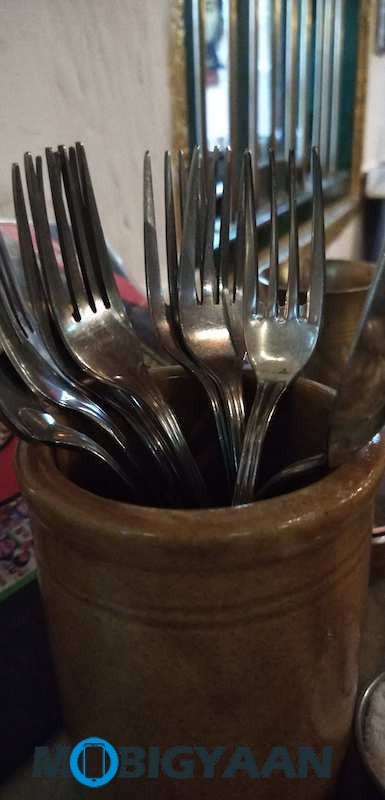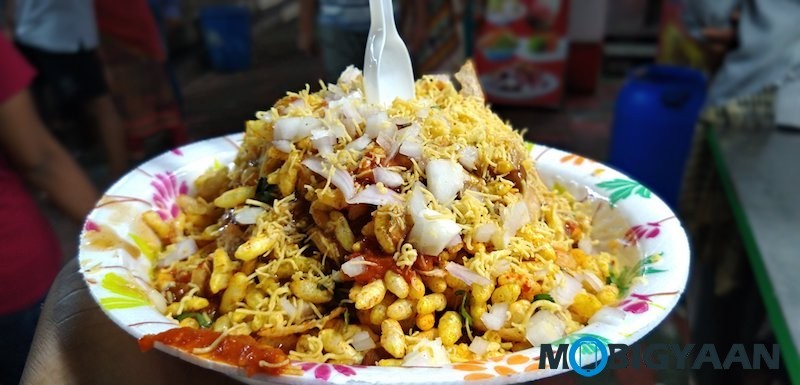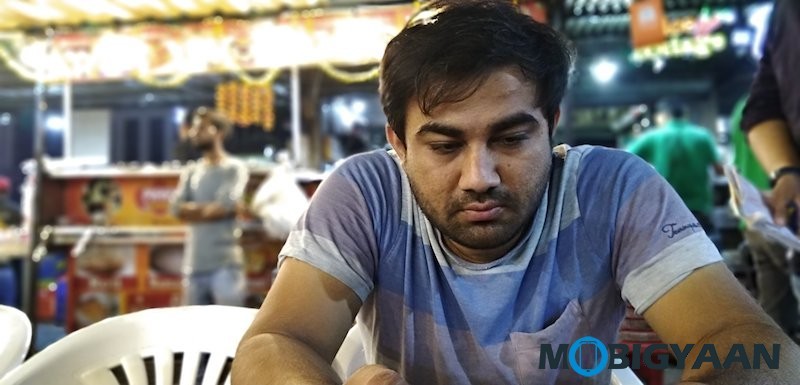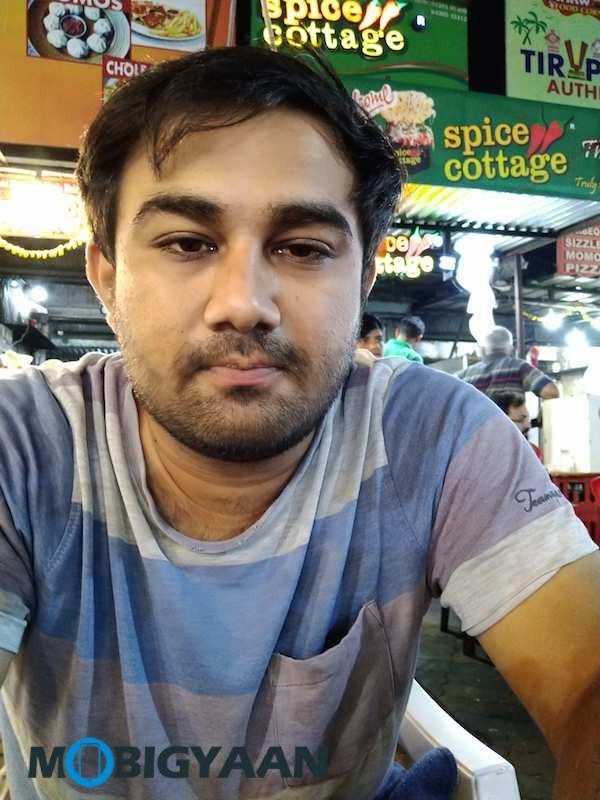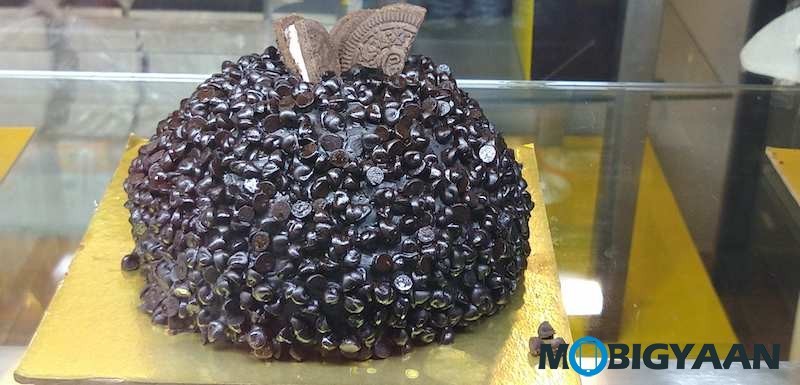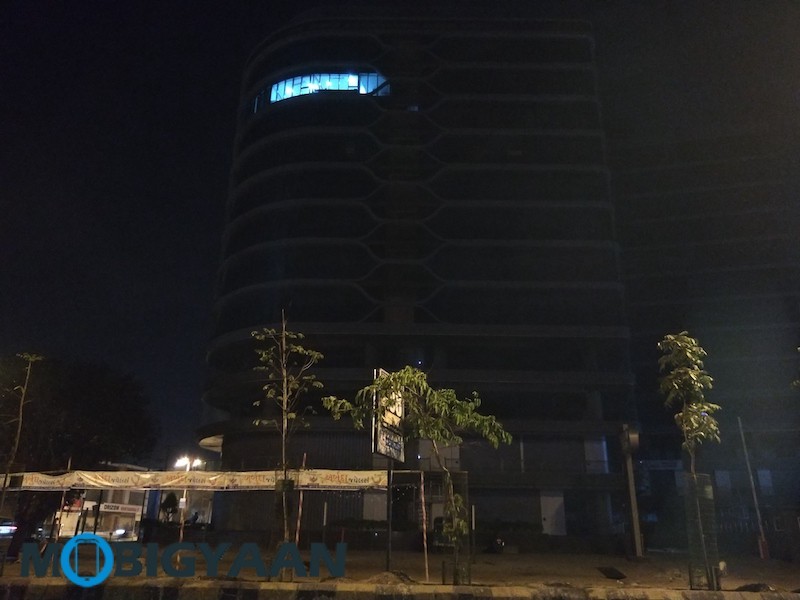Motorola One Power launched in India and this is the first Moto device to feature a notch screen and Android One. The Motorola One Power has some great things to offer such as the big 5,000 mAh battery, a larger screen, and it stands against the Nokia 6.1 Plus, ASUS ZenFone Max Pro M1, Xiaomi Redmi Note 5 Pro, and Mi A2 Android One. Here’s our Motorola One Power review.
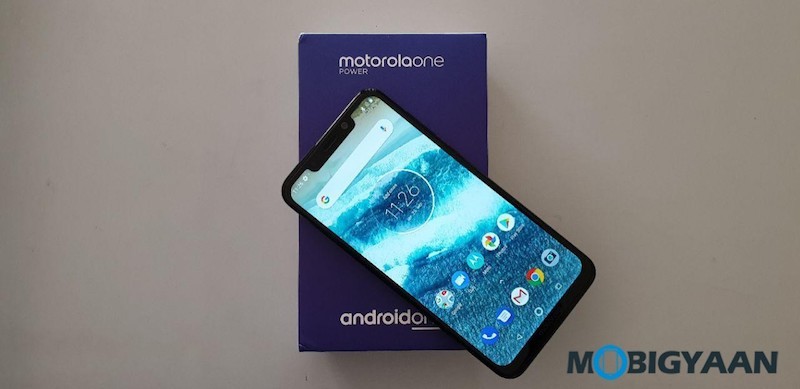
What’s in the box
- Motorola One Power
- Turbo Charger (12V, 1.5A)
- USB Type-C Cable
- Clear Silicon Flexible Case
- User Manuals & Warranty Card
- SIM Tray Ejector Pin
Motorola One Power Specifications
- Display: 6.2-inch Max Vision IPS display, Full HD+ resolution (2246 x 1080 pixels), 19:9 aspect ratio, 450 nits brightness
- Software: Android 8.1 Oreo (upgradeable to Android 9.0 Pie)
- Protection: P2i Water-Repellent Coating
- Fingerprint Scanner: Yes, at the back
- CPU: Up to 1.8 GHz octa-core Kryo 260 processor, Qualcomm Snapdragon 636 SoC, 14nm FinFET, 64-bit
- GPU: Adreno 509
- Memory: 4 GB RAM, LPDDR4
- Storage: 64 GB internal, up to 256 GB via microSD card (dedicated slot)
- Main Camera: Dual cameras 16 MP + 5 MP, Portrait Mode, 4K Video Recording, LED flash
- Selfie Camera: 12 MP, Portrait Mode, LED flash
- Connectivity: USB Type-C, 3.5 mm headphone jack, Wi-Fi, Bluetooth, GPS
- Cellular: 4G LTE, 2x nano SIM (GSM), dual-VoLTE
- Other: Dolby Audio, Google Lens, Widevine L1 Certification,
- Battery: 5,000 mAh with 15W TurboPower Charging
- Price: ₹15,999
- Availability: From October 5, Flipkart exclusive
Design, Build, & Ergonomics
The first thing about the phone is it’s bulky. Yes, the Motorola One Power weighs around 205 grams which is certainly heavy for may users. The design is quite solid, the metallic design gives you a great feel in the hands although the sides are made from plastic. Ergonomically, the sides are given curved which will provide you with a better grip.
The rear side boasts off dual-camera setup that is likely going to offer you bokeh-style photos (more in the camera section). You will also find the fingerprint scanner below the dual cameras on the Motorola moniker and an Android One tag down below. The Moto G6 and Moto G6 Plus come with a front mounted scanner instead.
The Qualcomm Snapdragon 636 also powers the Nokia 6.1 Plus, Xiaomi Redmi Note 5 Pro, and the ASUS ZenFone Max Pro M1 – the Motorola One Power competes with all three smartphones.
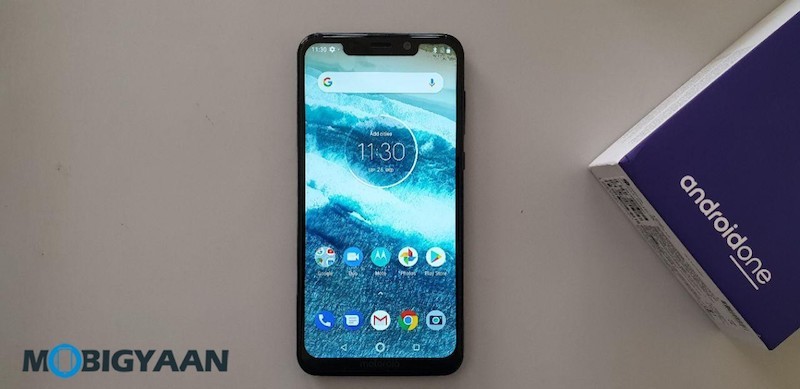
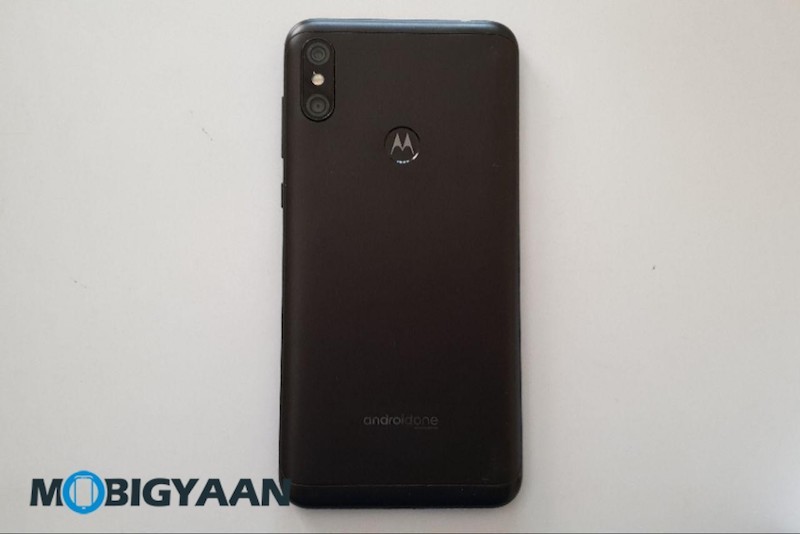
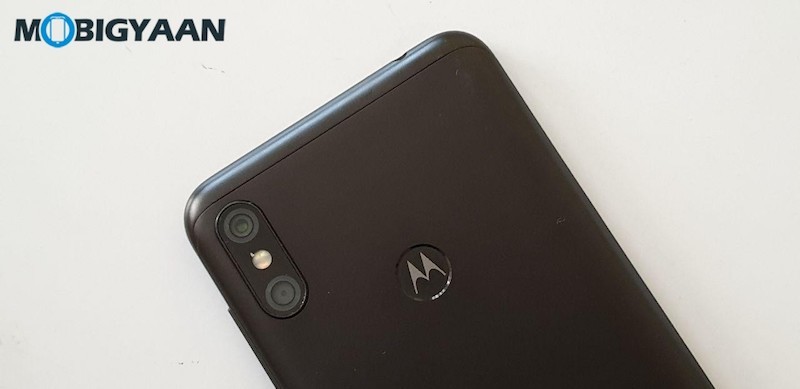
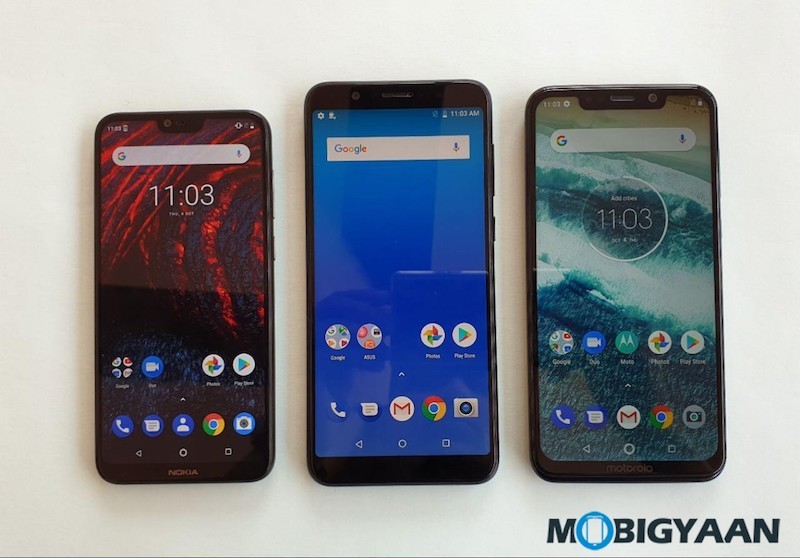
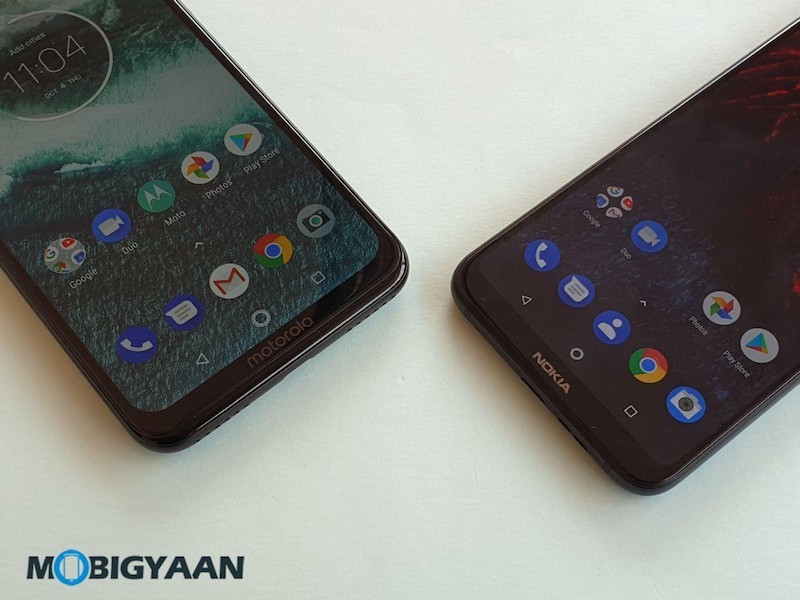
No, you don’t get a dual-VoLTE option on the phone, the dual SIM tray supports one 4G SIM at a time even though the Qualcomm chip inside supports the functionality. We are not sure whether Motorola will fix it with an OTA update, but as far as you are using the phone for the dual-VoLTE feature, you should pick something that supports it.
The bottom offers a USB Type-C port, loudspeakers, and a microphone. The top offers a 3.5 mm audio jack and another noise cancellation microphone.
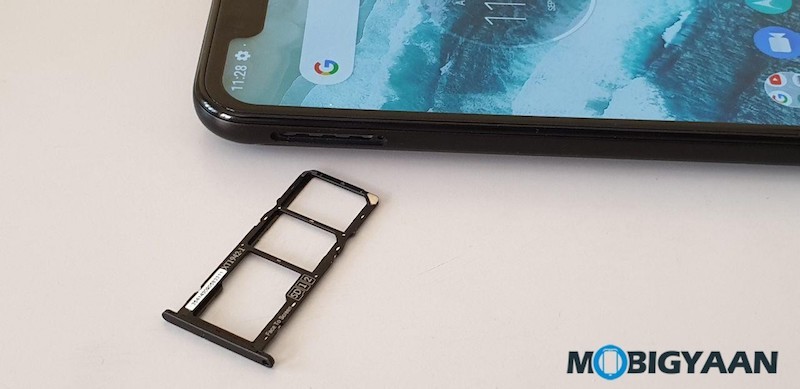
Display
The Motorola One Power sports a 6.2-inch Max Vision IPS display with a resolution of Full HD+ (2246 x 1080 pixels) and a wide notch that holds a 12 MP selfie camera, proximity sensor, and earpiece. The phone doesn’t offer any option to hide the notch since it’s an Android One device. Android One devices don’t offer any third party customizations and this is why the notch option is not available. We hope if it offers a similar option like on the Google Pixel 3.
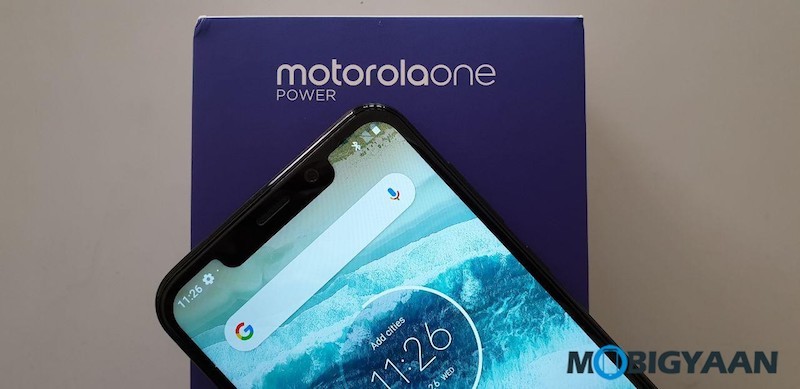
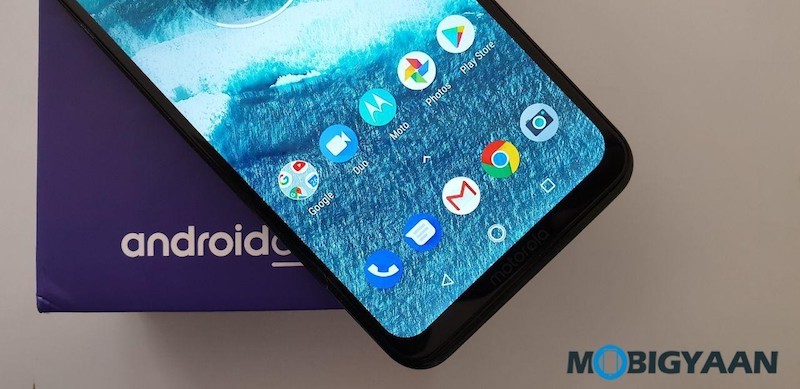
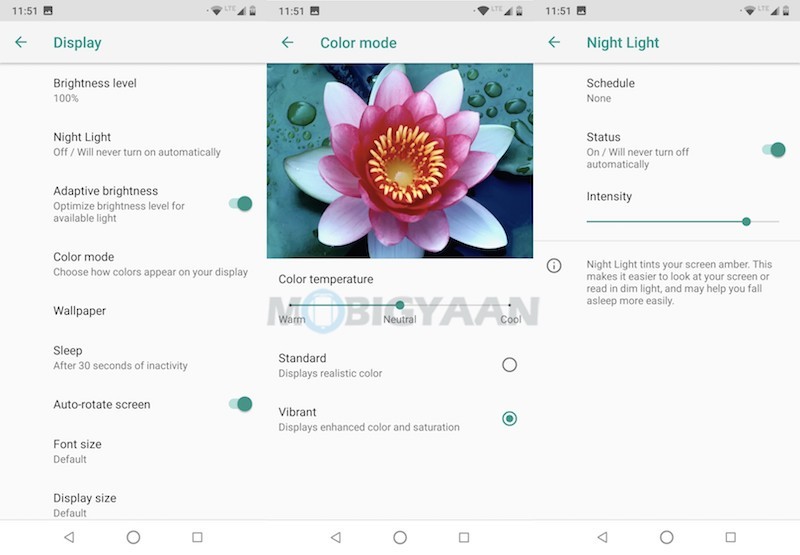
Software & User Interface
This is where the Motorola One Power shines out, it’s packed with Android One goodness meaning this is the phone that might have faster software updates than the competition and it’s one of the biggest advantages of the Motorola One Power. Android One smartphones run on stock Android and come with the promise of two years of Android version updates and three years of security updates.
You get the stock Android experience on the Motorola One Power running the Android 8.1 Oreo out-of-the-box, however, Android Pie out-of-the-box would definitely add a benefit over the others. Nevertheless, Motorola says it’s upgradeable to Android Pie. As it’s an Android One device, there is no bloatware other than the Moto app, Moto help, Dolby Audio, and FM Radio.
The Moto app includes the Moto Display that shows you a glance at the notifications on the screen without unlocking the phone, a trait similar to the Always-on display. The Moto Actions will add the gesture-based features like chop twice for flashlight and double twist to open the camera.
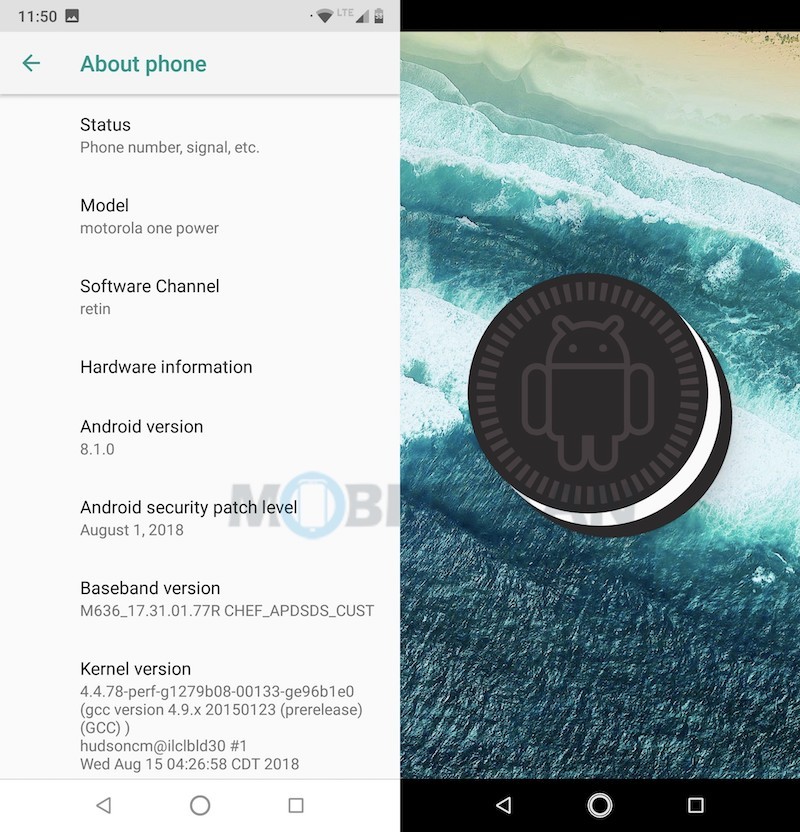
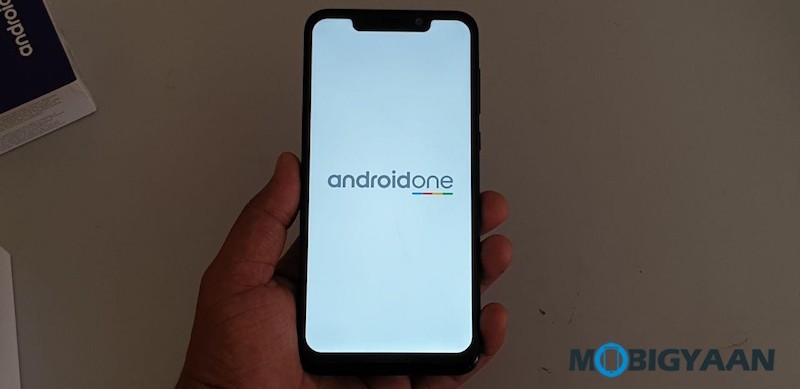
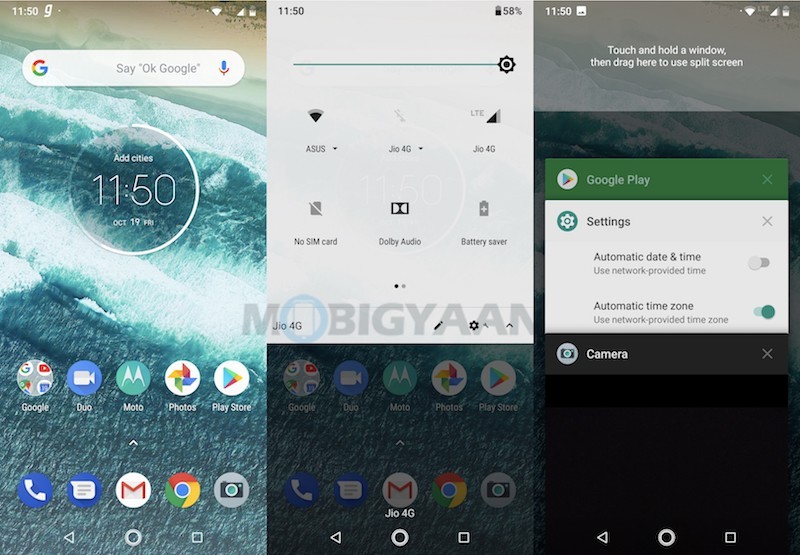
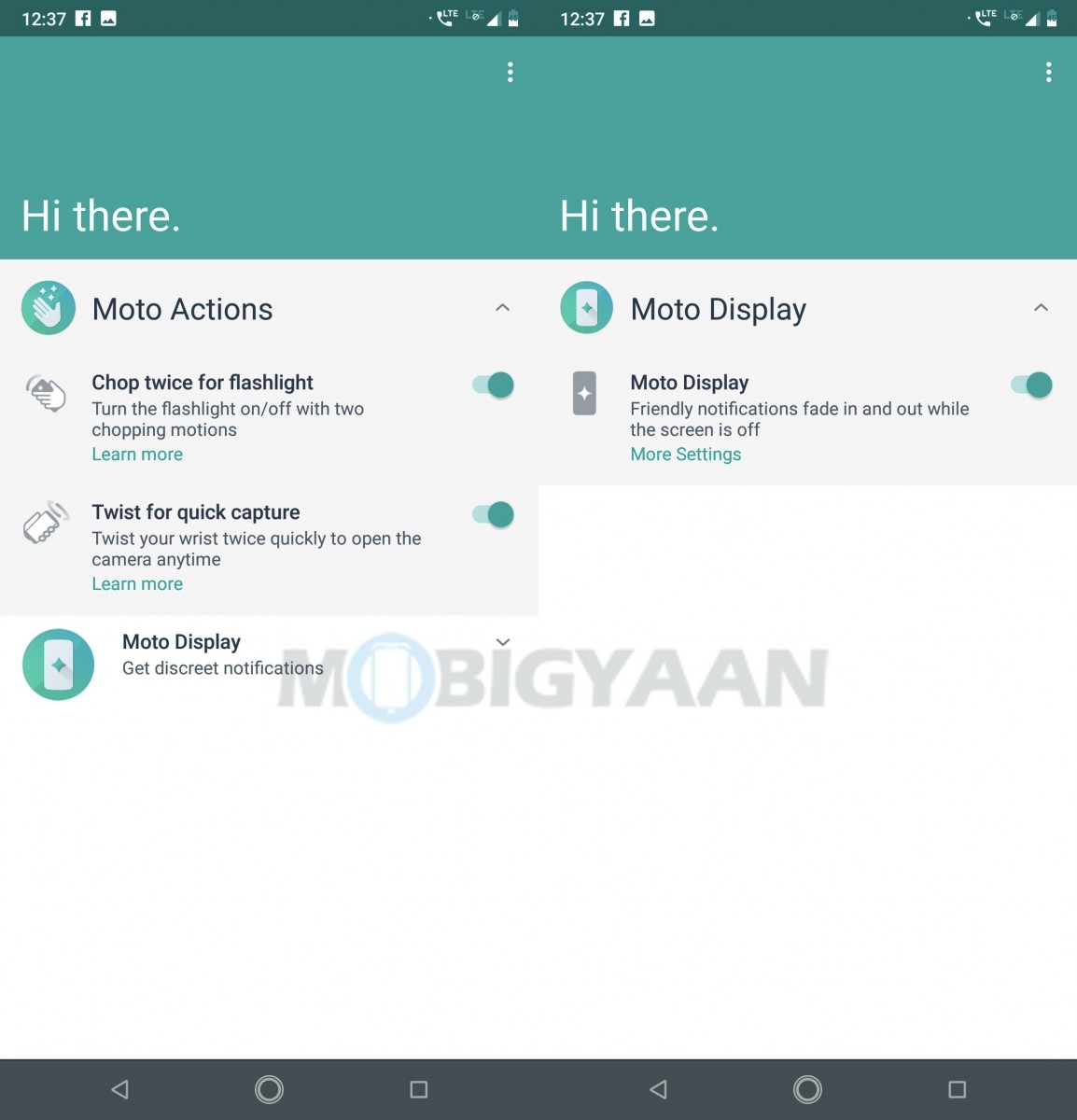
Hardware, Performance, & Gaming
The Motorola One Power is powered by Qualcomm Snapdragon 636 SoC which was first seen on the Xiaomi Redmi Note 5 Pro and found on other phones like Nokia 6.1 Plus, and ASUS ZenFone Max Pro M1. Other similar priced phones such as the Xiaomi Mi A2 Android One and the Realme 2 Pro are powered by the more powerful chip Snapdragon 660 SoC.
Furthermore, the chip is paired with 4 GB LPDDR4 RAM and 64 GB internal storage that expands via microSD card up to 256 GB. Graphics is taken care by Adreno 509 GPU which is sufficient for playing many games, if not all.
Motorola One Power Key Specifications
- Display: 6.2-inch Max Vision IPS display, Full HD+ resolution (2246 x 1080 pixels), 19:9 aspect ratio, 450 nits brightness
- Software: Android 8.1 Oreo (upgradeable to Android 9.0 Pie)
- CPU: Up to 1.8 GHz octa-core Kryo 260 processor, Qualcomm Snapdragon 636 SoC, 14nm FinFET, 64-bit
- GPU: Adreno 509
- Memory: 4 GB RAM, LPDDR4
- Storage: 64 GB internal, up to 256 GB via microSD card (dedicated slot)
- Battery: 5,000 mAh with 15W TurboPower Charging
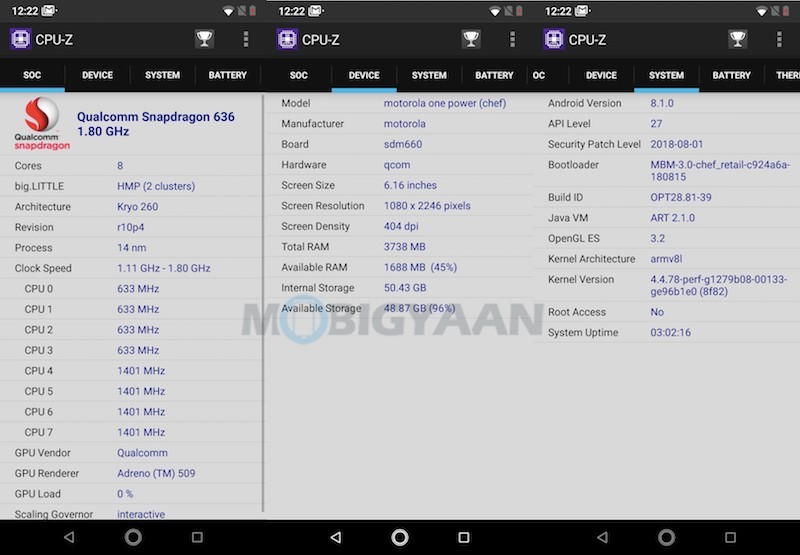
Moving to the benchmarks, AnTuTu scores 1,15,001 points which roughly equivalent (or slightly above) to the ASUS ZenFone Max Pro and Xiaomi Redmi Note 5 Pro. Geekbench scores 1,307 points (Single CPU), 4,900 points (Multi CPU), and 4,462 points (GPU). There is no doubt that the performance would be a lot similar to these rivals.
AnTuTu Benchmark
- 1,15,001 points
Geekbench
- 1,307 points (Single CPU)
- 4,900 points (Multi CPU)
- 4,462 points (GPU)
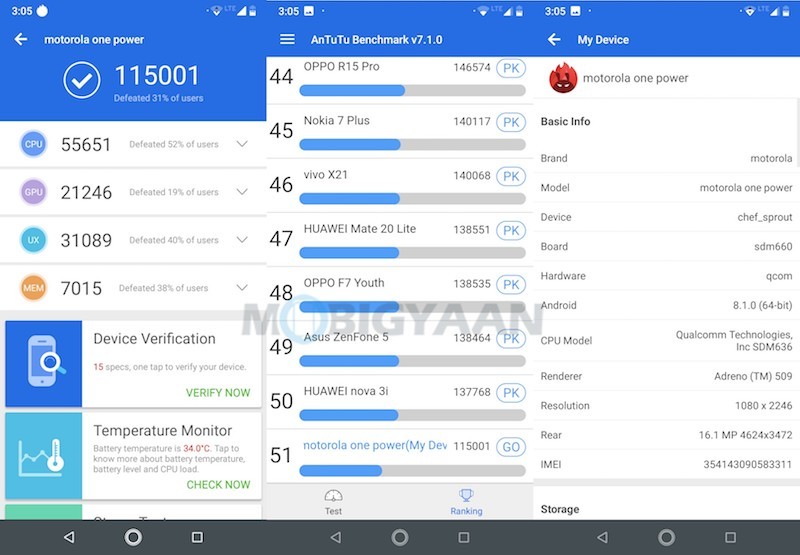
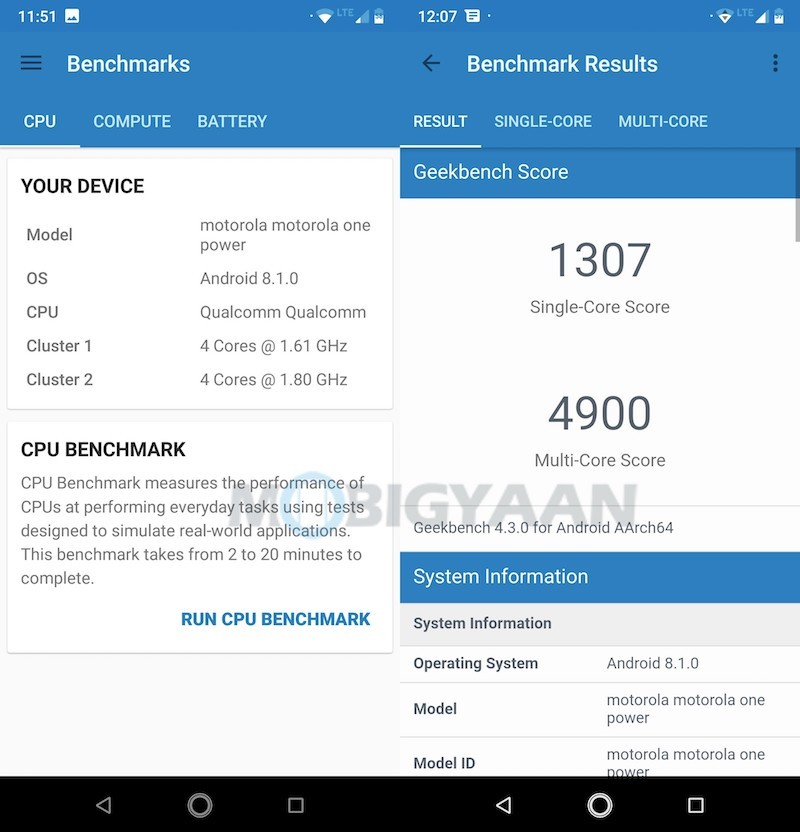
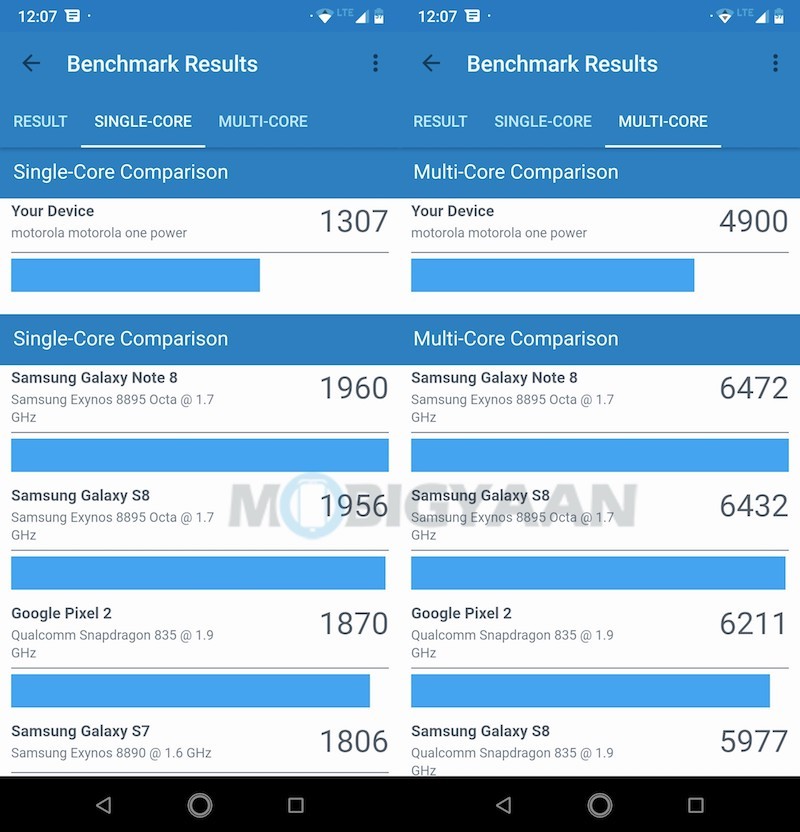
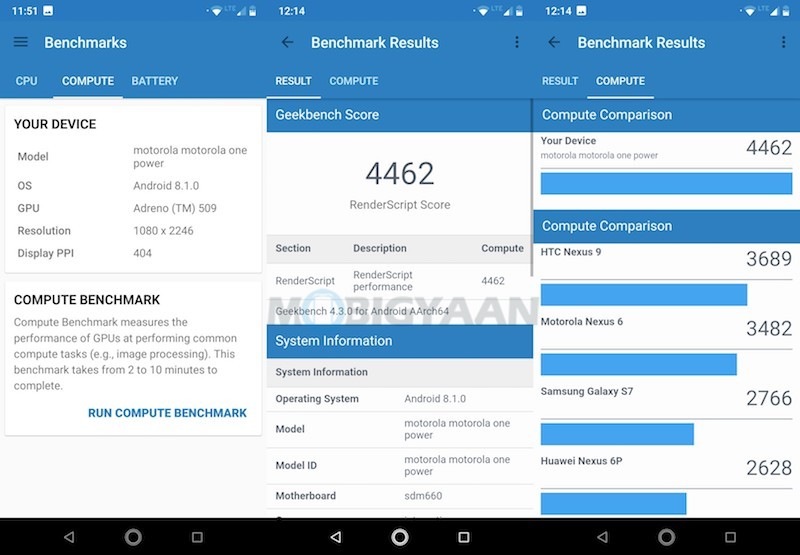
Gaming should be a problem on the Motoroa One Power, the Adreno 509 is suffificent for moderate gaming, however, if prefer better performance, the Adreno 512 would be better in terms of overall gaming. The Xiaomi Mi A2 and the Realme 2 Pro offers faster Adreno 512 GPU (Snapdragon 660 SoC). Good thing the device doesn’t heat much while gaming.
Games Tested on Motorola One Power
- PUBG MOBILE
- Asphalt 9: Legends
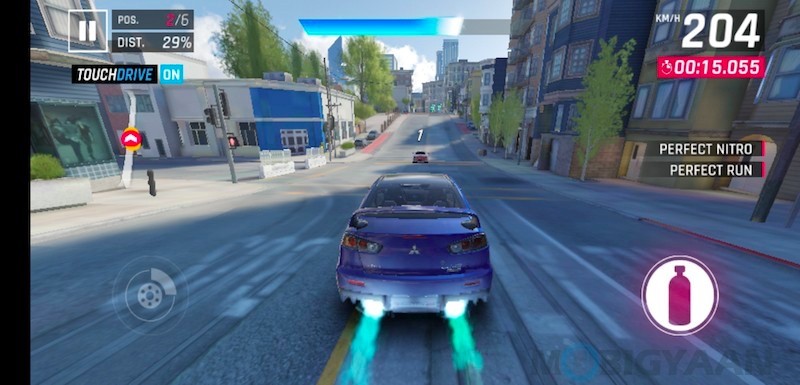
Storage & Memory Performance
On the Storage side, the Motorola One Power comes in only one variant i.e. 64 GB eMMC internal with support for a microSD card that expands up to 256 GB. The performance of the RAM and storage is also similar to the ones we mentioned above, nothing significant here.
A1 SD Bench
- 262.59 MB/s (Read)
- 233.50 MB/s (Write)
- 5,348.70 MB/s (RAM Copy)
AndroBench
- 276.27 MB/s (Sequential Read)
- 212.84 MB/s (Sequential Write)
- 62.65 MB/s (Random Read)
- 71.15 MB/s (Random Write)
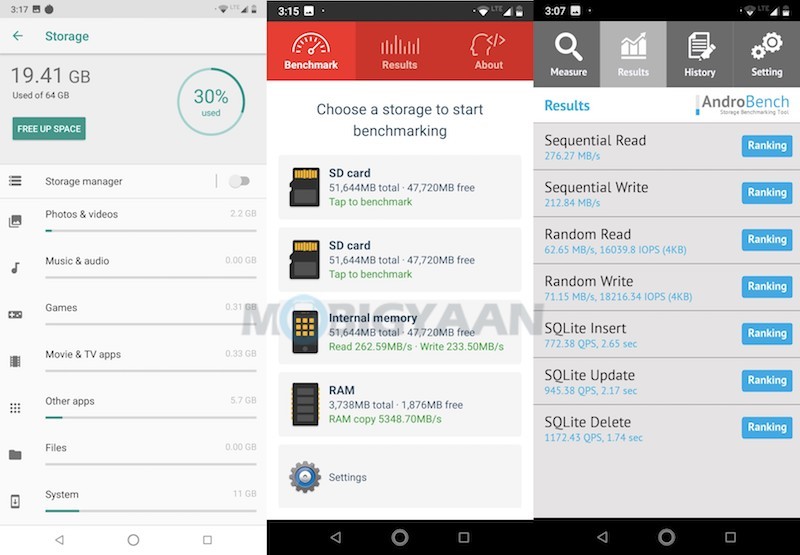
Cameras
Speaking of the cameras on the phone, the Motorola One Power doesn’t compromise here, you will find dual cameras, one with 16 MP main camera coupled with a 5 MP secondary camera for depth sensing. On the front side, there’s a 16 MP camera with LED flash to take care of your selfies.
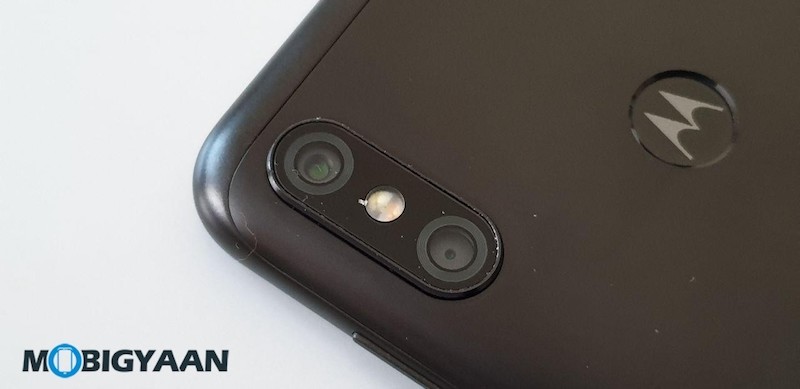
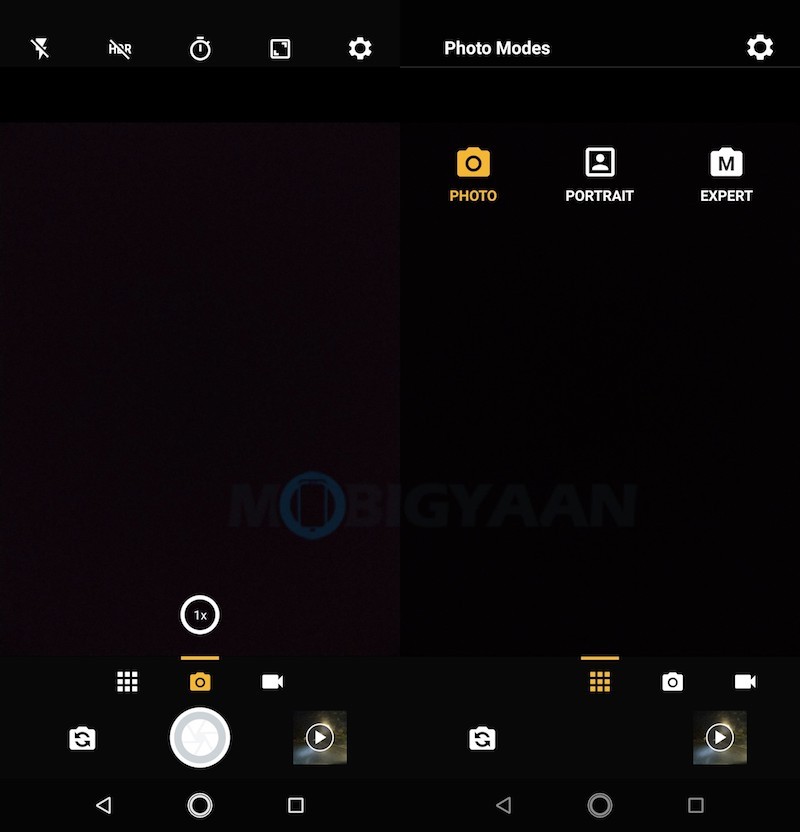
The camera’s user interface is pretty much stock and you don’t find much options rather than the Portrait mode, Expert mode and a few others like Beauty mode and 4K video recording.
The portraits turn out to be good in the daylight, during the night, the camera weakens. The daylight photography on the Motorola One power is fairly good and you will get some nice clicks but I had some camera focusing issues while taking photos especially at the low light areas. The selfies are good, but may not surprise you like the Xiaomi Redmi Note 5 Pro.
The camera performance isn’t that great, the competition can squeeze the Motorola One Power in the camera quality and features or overall camera package. Xiaomi Redmi Note 5 Pro is still one of the tough smartphones in the midrange segment to beat.
The camera also supports 4K video recording and we found no option for slow motion recording, plus the camera misses out on optical image stabilization and electronic image stabilization.
Take a look at the camera samples we took from the Motorola One Power’s cameras.
Motorola One Power Camera Samples
Battery
Aside from the main highlight that is it’s Android One, the Motorola One Power also packs a huge 5,000 mAh battery which is sufficient for a 2-day battery life. Our test suggests that the phone can survive the second day with around ~40% of the battery on moderate usage.
Our usage includes watching YouTube videos, music streaming, snapping photos and shooting 4K videos, light gaming, and social apps like Tik Tok. We played PUBG MOBILE and it took around 4% of the battery in a 22-minute gameplay. If you are a heavy user, you still get some battery juice left the other day. The battery life is amazing, we got a whopping 6 hours 40 minutes screen-on-time and still 40% battery left.
Having said that, its big battery comes takes a hefty time to charge, you will need to put the phone for more than 3 hours to charge the battery from 0% to 100%. Even though the phone comes with a fast charge rated 12V, 1.5A, the phone takes longer to charge.
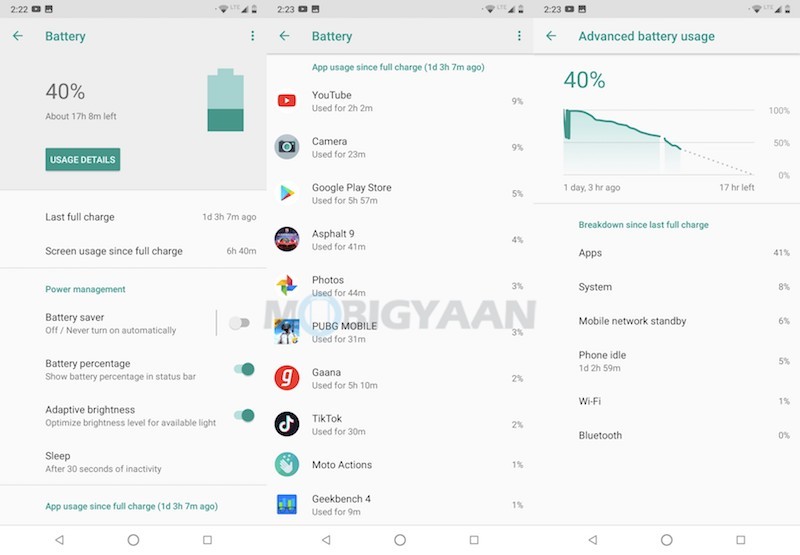
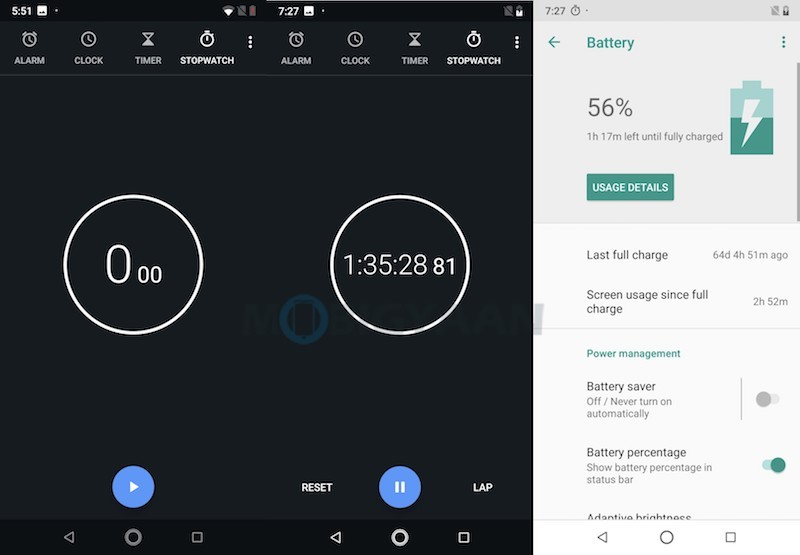
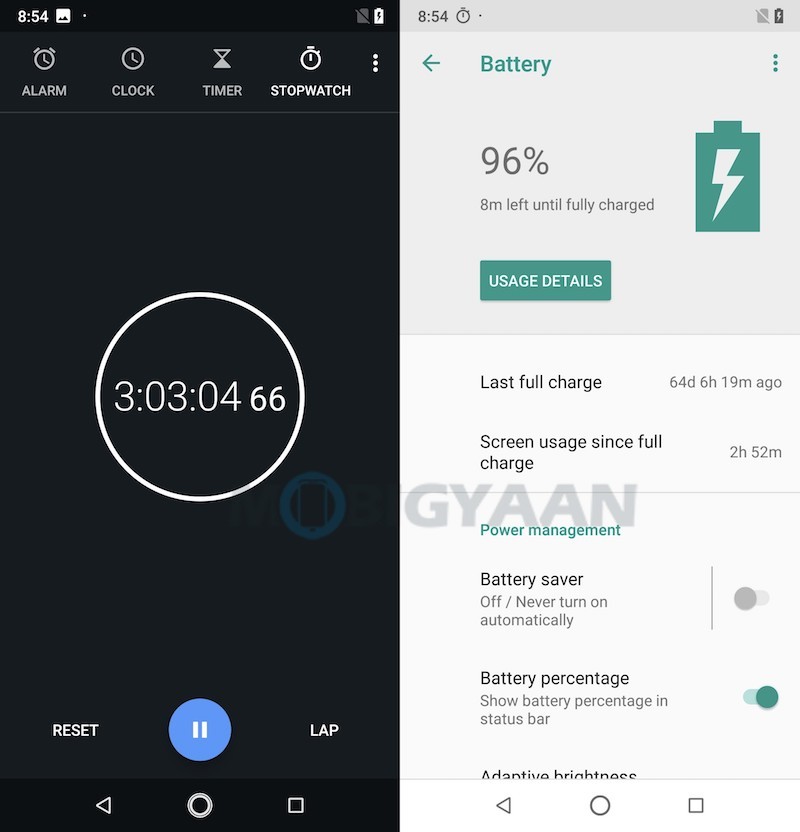
[table id=191 /]
Verdict
The Motorola One Power is a phone for Android One lovers, it has stock Android with Moto gestures, the battery life is amazing, and it offers a decent performance starting at Rs 15,999. A few things like lack of dual-VoLTE support, the bulky design, and the sluggish camera can’t be ignored. If you are looking for phones within a similar range, similar performance, and better cameras, the Redmi Note 5 Pro is still hard to beat one. The cheaper alternative ASUS ZenFone Max Pro M1 can be looked as well.
Rivals
- Nokia 6.1 Plus (64 GB) (Android One) – Rs 14,999
- Xiaomi Redmi Note 5 Pro (64 GB) – Rs 14,999
- ASUS ZenFone Max Pro M1 (64 GB) – Rs 12,999
- Xiaomi Mi A2 (64 GB) (Android One) – Rs 16,999
- Realme 2 Pro (64 GB) – Rs 13,990
Strength
- Large 5,000 mAh battery
- Faster Android Updates
- P2i Water-Repellent Coating
- Dedicated microSD support
- Good Build Quality
- Decent Performance
Weakness
- Cameras Could Be Better
- No Dual VoLTE Support
- Bulky (205 grams)

